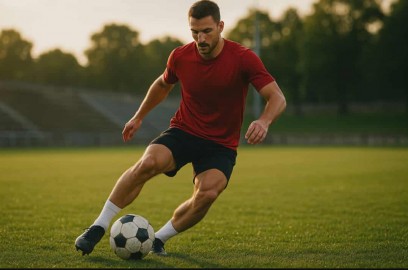
In modern football, everyone trains. Every player does drills, fitness, and ball work.
But not everyone develops the same way.
The real difference between good and outstanding players lies in technical precision – the small details that make your control cleaner, your first touch smoother, and your play faster and smarter.
The truth is simple: the higher the level, the less time you have on the ball.
So, if your technique isn’t sharp, you won’t survive under pressure.
This article shows you how to build a technical edge that makes you stand out from everyone else.
-
THE DIFFERENCE IS IN THE FIRST TOUCH
Your first touch decides everything – the tempo of your action, the space you gain, and the options you create.
At professional level, one perfect first touch can destroy an entire defensive setup.
Smart players don’t just “control” the ball – they guide it with purpose. Every touch has direction.
Train your first touch like this:
-
practice receiving passes from different angles and speeds,
-
always aim to move the ball into open space, not toward pressure,
-
use both feet and various surfaces – inside, outside, sole.
A clean, directional first touch turns you from a reactive player into a proactive one.
-
REPETITION WITH PURPOSE
It’s not enough to do 1000 touches a day – you need to know what each repetition teaches you.
Repetition without focus only creates habits, not skills.
Every drill must have a clear micro-goal, for example:
-
improving first touch under pressure,
-
learning to dribble with eyes up,
-
working on balance while turning with the ball.
Film your sessions, observe your body positioning, and make adjustments.
Technical mastery is not magic – it’s thousands of mindful, corrected repetitions.
-
LEARN TO CONTROL SPEED
One of the biggest technical skills is the ability to play fast without losing control.
Many players try to do everything at full pace and end up losing precision.
Elite players, on the other hand, know when to slow down, pause, and explode again.
Drill idea:
-
perform a dribbling run at 70% speed, focus on precision,
-
then accelerate for the last 10 meters, maintaining full control,
-
repeat until your touch remains stable at every tempo.
Control is what allows speed to become useful.
-
TRAIN UNDER PRESSURE
Football is not a training ground full of cones – it’s chaos, noise, and pressure.
That’s why the best way to improve your technique is to simulate real match intensity.
Include these elements in your training:
-
small-sided games (3v3 or 4v4) in tight spaces,
-
time limits for decisions (e.g., “you have 2 seconds to pass”),
-
training with contact or physical challenge.
When your technique works in chaos, it will shine in competition.
-
BUILD BODY CONTROL AND BALANCE
Great technique doesn’t come only from your feet – it comes from your entire body.
Watch top players: their control, turns, and changes of direction depend on core strength and balance.
Add these exercises to your routine:
-
single-leg balance with a ball toss,
-
side lunges with the ball,
-
quick changes of direction after passes.
If your body is stable, your touch becomes cleaner.
-
QUALITY OVER QUANTITY – ALWAYS
You don’t need to spend three hours juggling or dribbling around cones.
Even 45 minutes of focused, detailed technical work can move you forward more than any long, unfocused session.
The key rule is simple:
Every repetition must have meaning.
Every movement must have purpose.
That’s how professional players train – efficiently, deliberately, with full concentration.
SUMMARY
A player with superior technique controls not just the ball, but the entire game.
Your opponents may be stronger or faster, but if your touch, timing, and precision are better, you will always have the advantage.
Train details.
Train consciously.
Because in football, the smallest technical improvements often create the biggest difference.





